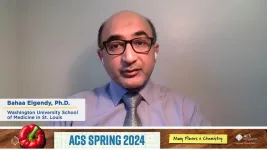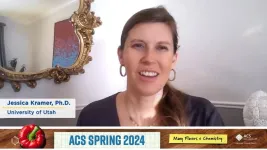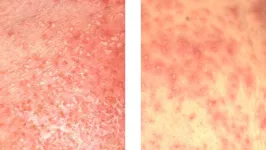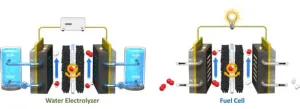(Press-News.org) Anyone who wants to produce medication, plastics or fertilizer using conventional methods needs heat for chemical reactions – but not so with photochemistry, where light provides the energy. The process to achieve the desired product also often takes fewer intermediate steps. Researchers from the University of Basel are now going one step further and are demonstrating how the energy efficiency of photochemical reactions can be increased tenfold. More sustainable and cost-effective applications are now tantalizingly close.
Industrial chemical reactions usually occur in several stages across various interim products. Photochemistry enables shortcuts, meaning fewer intermediate steps are required. Photochemistry also allows you to work with less hazardous substances than in conventional chemistry, as light produces a reaction in substances which do not react well under heat. However, to this point there have not been many industrial applications for photochemistry, partly because supplying energy with light is often inefficient or creates unwanted by-products.
The research group led by Professor Oliver Wenger at the University of Basel now describes a fundamental principle which has an unexpectedly strong impact on the energy efficiency of photochemistry and can increase the speed of photochemical reactions. Their results are published in Nature Chemistry.
In the case of this kind of reaction, the starting molecules are in a liquid solution. If they receive energy in the form of light, they can exchange electrons with one another and form radicals. These extremely reactive molecules always occur in pairs and remain surrounded by solvent, which encloses the pairs of radicals like a kind of cage. In order for the radicals to be able to continue to react to the desired target products, they need to “break out” of this cage and find a reaction partner outside of it. The team surrounding Wenger and his postdoc Dr. Cui Wang identified this process of breaking out as a decisive step which limits the energy efficiency and the speed of photochemical reactions.
Radicals break free
As long as the radicals remain in pairs in the solvent cage, they can spontaneously react with one another back into the starting materials. This reverse reaction wastes energy because it only uses the light already absorbed to get back to the starting point. The Basel team was able to slow down this reverse reaction and therefore give the radicals more time to leave the cage. The longer the unwanted reverse reaction became, the more radicals were able to break out and the more energy efficient and faster the desired target products developed.
Wang, who now holds the position of assistant professor at Osnabrück University, used two particular dyes in her study, both of which absorb light and store its energy for a short period before using it to form pairs of radicals. However, one of the two dyes examined was able to store significantly more energy than the other and transfer it to the radicals. Due to the additional energy, the radicals were able to leave the solvent cage up to ten times more efficiently. Consequently, the target products are produced with up to ten times higher energy efficiency. “This direct link between the radicals breaking out of the solvent cage and the efficient formation of the target products is astonishingly clear,” stated Wang.
Dyes are key
The key finding is that certain dyes can release more radicals than others per the amount of light absorbed. “The choice of dye can be used to boost the energy efficiency of photochemical reactions,” emphasizes Wenger. In turn, he states that energy efficiency is also a decisive criterion for the industrial use of photochemistry.
END
Using light to produce medication and plastics more efficiently
2024-03-18
ELSE PRESS RELEASES FROM THIS DATE:
Mapping the evolution of urinary tract cancer cells
2024-03-18
Researchers at Weill Cornell Medicine have performed the most comprehensive analysis to date of cancer of the ureters or the urine-collection cavities in the kidney, known as upper tract urothelial carcinoma (UTUC). The study, which compared the characteristics of primary and metastatic tumors, provides new insights into the biology of these aggressive cancers and potential ways to treat them.
In the study, which appeared March 18 in Nature Communications, the researchers examined tissue samples from 44 primary and metastatic UTUC tumors. They compared gene mutations ...
Implantable sensor could lead to timelier Crohn’s treatment
2024-03-18
· Temperature sensor warns of disease flareups, tracks disease progression in real time
· Currently no way to quickly detect inflammation, leading to invasive surgeries
· Strategy could be useful in ulcerative colitis, another inflammatory bowel disease
CHICAGO --- A team of Northwestern University scientists has developed the first wireless, implantable temperature sensor to detect inflammatory flareups in patients with Crohn’s disease. The approach offers long-term, real-time monitoring and ...
Glucose levels affect cognitive performance in people with type 1 diabetes differently
2024-03-18
A new study led by researchers at McLean Hospital (a member of Mass General Brigham) and Washington State University used advances in digital testing to demonstrate that naturally occurring glucose fluctuations impact cognitive function in people with Type 1 Diabetes (T1D). Results showed that cognition was slower in moments when glucose was atypical – that is, considerably higher or lower than someone’s usual glucose level. However, some people were more susceptible to the cognitive effects of large glucose fluctuations than others.
“In trying to understand how diabetes impacts the brain, our research shows that it is important to consider not only how people ...
Mimicking exercise with a pill
2024-03-18
NEW ORLEANS, March 18, 2024 — Doctors have long prescribed exercise to improve and protect health. In the future, a pill may offer some of the same benefits as exercise. Now, researchers report on new compounds that appear capable of mimicking the physical boost of working out — at least within rodent cells. This discovery could lead to a new way to treat muscle atrophy and other medical conditions in people, including heart failure and neurodegenerative disease.
The researchers will present their ...
New composite decking could reduce global warming effects of building materials
2024-03-18
NEW ORLEANS, March 18, 2024 — Buildings and production of the materials used in their construction emit a lot of carbon dioxide (CO2), a potent greenhouse gas that contributes to global warming and climate change. But storing CO2 in building materials could help make them more environmentally friendly. Scientists report that they have designed a composite decking material that stores more CO2 than is required to manufacture it, providing a “carbon-negative” option that meets building codes and is less expensive than standard composite decking.
The researchers will present their results today at the spring meeting of the American Chemical Society ...
Artificial mucus identifies link to tumor formation
2024-03-18
NEW ORLEANS, March 18, 2024 – During cold and flu season, excess mucus is a common, unpleasant symptom of illness, but the slippery substance is essential to human health. To better understand its many roles, researchers synthesized the major component of mucus, the sugar-coated proteins called mucins, and discovered that changing the mucins of healthy cells to resemble those of cancer cells made healthy cells act more cancer-like.
The researcher will present her results today at the spring meeting of the American Chemical Society (ACS). ACS Spring 2024 is a hybrid meeting being held virtually and in person March 17-21; it features nearly 12,000 ...
Study explores homeless women’s experiences of ‘period poverty’
2024-03-18
Research from the University of Southampton has identified common issues women face when experiencing periods while homeless.
A review of research published in Women and Health has found homeless women experienced practical challenges in managing menstruation alongside feelings of embarrassment and shame, with many ‘making do’ due to inadequate provision.
The researchers say it’s high time to address the provision of menstrual health resources as a basic human right.
Dr Stephanie Barker, a teaching fellow at the University of ...
Keeping score: novel method might help differentiate 2 serious skin diseases
2024-03-18
Your skin becomes red and spots filled with pus appear, so you visit a dermatologist. When these symptoms spread to the skin throughout the body, it is difficult for the physician to distinguish whether it is generalized pustular psoriasis (GPP) or acute generalized exanthematous pustulosis (AGEP), as both have similar symptoms. The two diseases run different courses and require different treatments. Without proper treatment, the symptoms can worsen severely and cause complications, so it is essential to distinguish between them.
Researchers ...
Developing bifunctional catalyst performance enhancement technology that will dramatically lower the cost of hydrogen production
2024-03-18
Dr. Hyung-Suk Oh and Dr. Woong-Hee Lee of the Clean Energy Research Center at the Korea Institute of Science and Technology (KIST), in collaboration with POSTECH and Yonsei University, have developed a methodology to improve the reversibility and durability of electrodes using bifunctional platinum-nickel alloy catalysts with an octahedral structure that exhibits both oxygen reduction and generation reactions.
Bifunctional catalysts are a new generation of catalysts that simultaneously produce hydrogen and oxygen from water using a single catalyst. Currently, electrochemical systems such as water electrolysis technology and CCU (carbon dioxide ...
Animal hair structure changes from summer to winter to fend off freezing weather
2024-03-17
NEW ORLEANS, March 17, 2024 — Unique adaptations allow wild animals to survive temperature extremes that would quickly kill an unprotected human. For example, certain animals can withstand bitterly cold weather, thanks to the insulating properties of the hollow hairs that make up their coats. Little has been known about the hairs, but now, researchers have discovered that their inner structure changes with the seasons.
The researchers will present their results today at the spring meeting of the American Chemical Society (ACS). ACS Spring 2024 is a hybrid meeting being held virtually and in person March ...






